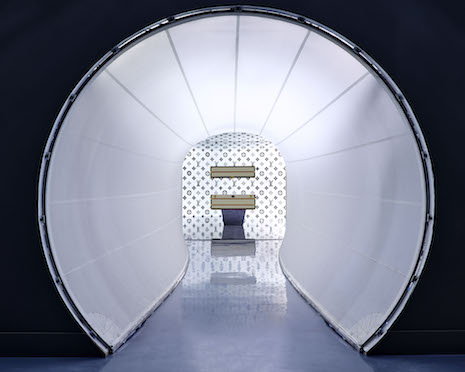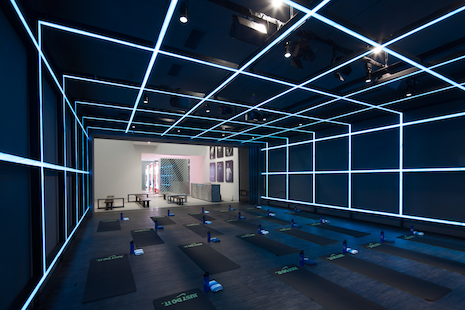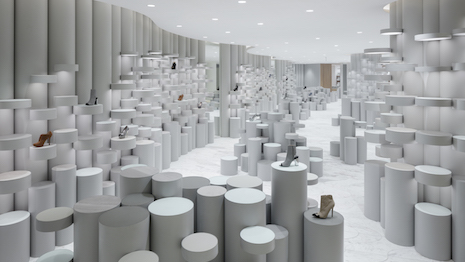By Jonathan Openshaw
The ecommerce revolution of the late 1990s and early 2000s brought about such a dramatic shift in the retail sector that some commentators were quick to declare the death of bricks and mortar altogether.
Bytes had replaced atoms, it was thought, and soon we would dispense with physical stores altogether in favor of the cool, digital efficiency of online.
Certainly, retail was dramatically disrupted by these advancements in technology, but the last few years have witnessed a fascinating renaissance in the bricks-and-mortar model.
Dwell on it
Instead of trying to compete with the speed of online, many physical stores are refocusing on what they do best: providing touch points with consumers and building brands, rather than just flogging units.
At its most extreme, this trend is leading to stores that actively frustrate the consumer’s journey to purchase instead of trying to speed them to checkout. Dwell time now becomes more important than spend.
 Series 3 exhibition by Louis Vuitton, London
Series 3 exhibition by Louis Vuitton, London
Following the logic that if you get consumers to emotionally invest in your brand through physical interactions, they are more likely to financially invest in the brand at a later date, perhaps through your ecommerce offer.
We call this trend “Explorium Retail” and have been tracking it for over a year now, scouring the globe for best-in-class examples.
South Korean eyewear brand Gentle Monster provides a master class here.
Originally launched as an online-only brand back in 2011, its buoyant ecommerce offer meant that the move into bricks and mortar was freed from the tyranny of transactions. Instead of peddling specs, Gentle Monster stores peddle stories, and they now boast several immersive and challenging showrooms.
“We believe inspiring spaces help to sell products,” said Jae Ho Bae, head of interiors at Gentle Monster. “Customers don’t remember products when they visit a space, they remember the architecture and artwork curated within the space.”
One of the brand’s most ambitious showrooms to date houses the Quantum Project, an ever-evolving space that changes on a 25-day turnaround, working with local artists and designers on each new reincarnation.
 Siam Discovery by Nendo, Bangkok. Photography by Tegumi Oka
Siam Discovery by Nendo, Bangkok. Photography by Tegumi Oka
“Stores are not just about consumption anymore, they are platforms for connection, participation and mystery,” said Martin Kwaskowski, creative director at Milligram studio and one of the retail experts we spoke with in researching this trend.
“Instead of just creating a story, brands need to share their value system and allow multiple stories to emerge,” he said.
A more mainstream example comes in the form of Samsung’s latest flagship space in New York, 837.
Launched earlier this year and described as a digital playground rather than a retail concept, the space is packed with everything from interactive artworks to performance spaces.
Everything, that is, apart from product: consumers are not actually able to buy anything at 837. Instead, the focus is on interaction and experience.
 Series 3 exhibition by Louis Vuitton, London
Series 3 exhibition by Louis Vuitton, London
A similar logic can be traced in recent luxury initiatives such as Louis Vuitton’s Series 3 space launched in London last year, where creative director Nicolas Ghesquière and set designer Es Devlin collaborated to create a rich and immersive brand experience that went beyond retail.
Has legs
The Explorium Retail trend is not only limited to luxury and technology, however. We are tracking it across retail categories.
The recently launched Nike Studio in Beijing, for example, eschews the bold simplicity associated with sportswear retail spaces in favor of a moody, challenging environment that aims to push consumers to their physical peak and unlock their mental potential.
 Nike Studio created by Coordination Asia, Beijing
Nike Studio created by Coordination Asia, Beijing
The Adidas run base in Berlin also combines aspects of a wellness and nutrition center, delivering far more to their consumers than trainers and t-shirts.
This renaissance in physical formats needs to be seen within the broader context of the move towards an experience economy, where many consumers – especially in the luxury sector – are looking for emotion and access rather than just acquisition.
According to recent research from Harris Poll, 78 percent of millennials would now choose to spend money on an experience or event over buying a desirable object.
That statistic is a staggering and perhaps alarming figure for retailers who are wedded to flogging merchandize and gives pause for thought about how we approach our physical retail spaces in the future.
Instead of the luxury flagship model of gleaming glass and cool marble, we may be seeing the rise of “brandships”: convergence spaces where consumers can explore anything from culture to fitness or education.
The aim here is to get people to linger for longer, exposing them to your brand message and building loyalty.
IT IS A bold new world for retailers to engage in and one that demands a business plan that can encompass the long game rather than immediate dividends.
The ultimate prize is engaging with consumers on a lifelong journey rather than just making a swift buck.
 Jonathan Openshaw is editorial director of LS:N Global
Jonathan Openshaw is editorial director of LS:N Global
Jonathan Openshaw is London-based editorial director of LS:N Global, the insights platform for lifestyle trends forecasting consultancy The Future Laboratory. Reach him at [email protected].
{"ct":"wo1E+ZyP+5H\/FASn1MkOzLh4dd\/KAsvLTmjS1B+ZK9P+YBqH2d5+52a8k2I9W0ku+5vc1a9fsAZ4vCkkMNrVuLFmKJ2e\/f0mO78gLg\/s\/e5MWhAnEXE1cvVgZI5s9PdkpFyX98TkpDlREN2xkVYMLALHUGhcwOIjEUwENiLLmQVbaJxIW25UHYHuZ5\/kL2mgCXp\/KE2FWXv7KP8Q75BmgEJGDjZiZTL2HPlEgU1dcoor8w4qyJTLItAZClZ5Gf7UUDYyOzogGaPPo9bSljYgZyn3m5R2rfO5ee4PTJqI6rQCQ82whBjE0bcjr\/KvBAUrXtM\/apO07p\/MHqjV3H3nOrd22Qu6rG02wFkCyoOHDVg2FxHUGzdRw0MPutC3g+EYIrkAkrG1Z4ym9NdTyx9Uy853ccjGofdPoJ3NKZK1kqpuk2y55dT12Qtx\/pe76wWJC7vuDSprMo1UjNXTCVDAxwLVj1PRZ8gXy92D\/W4yLrA0qVRpym9zf1UkXHOozxV0ptMs\/zvzxc+qqBH38AANLVD3pYyu+riSB\/XiSEAmnn+SyaJG8mvRO4n9DYarzv14gKI3HFX5e1Oi+Kn\/pTbg+Z1qG\/1pwMlu2nhjkF2+MJslngAQ7LnBtQwCyFaogrS\/C1kSfcj+R7es38Q2qKGEyIm8AcaOQ2szJjB7SpKhe\/wB836ut3IWF\/XUMXcRjdBiXPXH3YJBnQsMi\/hDvYWjkm+x+WCpMEVUFPIo5AdFP3WM8onyFlIY7xSYyd0P7Y+pyeEVnpDuj4Zyw1Bhm0Jwm6H3CdCLc0CgYUrroa4NM3yK5wKHL7jK7l3IbTEZjm8Zn6e8LneXEQiFjk8zXBy5ZNRWRW+jnrovJ60yF09QJj6OyN+N2qXuLRBiCCzA9+T4C3innpFA68ovdCoIzO+OibKb79UWJ4tpa6wkh8cE6DHJbcV3F\/jEnviumMy7dF0mEMCRxVbPyrPCm4a3QzsYkifTb8kZ29csbhBAHxPCQx4LaMG5UZlMoin+6aPXirHAnLADqs7ku+QA9pdGVDwo89lHDGfcKgKhtlFLD5ijjwYqYZOgHLpjPyl5d1nWudPWEzueJzBtZlAvdKKZO\/1qm\/HPcfiKpyqfv2iv5pkvpRtdAPg2LRM4qBhPD8HYNKFGikoA9RT8wgURjL36ICVQpz+rWreP8i2UUXUPQQ9elhOM4V0Hr3rA51tgu2MtksUfCARAW7g\/sBIZ9G1hK8y6pNPsyRKxDB8vi0JiFEnczdIX0MjNhjycNOOb4tilyR7pymtqpfYA+tokYY36njcmEgFjYpC\/l9zXjMsXl3AhokSMSWcgRXpTzzYxFchofxVJaKDWYjJT3QrU1qEaJQDRcaw4bVD8tSbZJBFQ1CtIJpyAvA7j0b6gUl8F+6pEu0x1QEhiRNgtlY5dHXkeXGLeEMrHGzIJuEW8TTKgYTVGwNQ3eQNtGgSV\/0gnG3z3ehTWXRDQ1sTf5VrBpNrsqXpRGvLdvIDOb8+P4T5IHVSQz57uVAwxQvJGcP1Skn5NKL\/SLu9zEvmrkuAvGSXt+ZmQQDBZ5Moj4jNm+Z6gPpUzg11xS5cEfx8psXU0NXjiDasTGk0bywYPz6JQRawDh\/BCTbA2xJhpqrtB12Igm\/GTg25JntjBInhzbuIXUDnwAbPWYJmZp\/ZGbKGc1R12FcvnxEHrvtceeWNM7vkl\/FDvAV2LlfH+4RQ0YvN\/Rb5BFirp6ZJr1ihS\/1zmK8sobO8vzdDDvO19RaIrZzOrM0RT3H+1UmqjzN6ffK1Vm5AIb5O+Wp+DsPRReRdm0G5DSWpUlAvTftRjNuj8eJSB6ghpUKdTK4Aw\/p0sCXLOw8W2djg+r\/3SK82YON\/dqpGZ34MMip06v9gkW2tJ91Yf9M\/MKRAPnt\/8Elcf672G8210jYTdzKUlZnzlWZaAySgkyymh1sYZkWcQ9xCnFHBV9YTtalGN2YZfEy9eRWIAkTWL0z8EcP6UvNzBamT2BIdJos70S0w2QknWm\/Y5P2ajUrZKmRNwB7xfbu4QWjShrVfkqS1CjNMby7NVSNUA\/tcb8gVALHPprJ8r7FeK\/J7EKlrF+4\/GQj3JfQ0rrTmVGUVn9BhTaruXfP8d7EtNAUmtnre1cFaJXvLf7RqqUZISOh4wXVqkPsJS71aPjhWurCx827u2VQ\/X+Z18sHmmssb21VqT6uDEOH23A1Ew3XfeGZo8SyonjYendQ\/lGF+tmV5MpqRtrNNQbX9qfbOUH62PFFQ+kpgFOB7n3aaOi2hXAgqbLUNchRcg2gsFUF\/EP+i\/0Vb6ZltNviRAJ7DghG6IrFIeFybVsY3A4EQc+Y8i2UOZvXLuNwvEu\/GoIxbj26iGKZ9ZDc53XdYMqIK4BGx78rtGqLizl8w5ZUmGElrgBkCB9XkoXlwjDtxzQJBA0R7plPV\/DfWVTDU1Ofx\/RUogBYKMc7CIoOI4x1HyoJ+Ek0YnQjh9SkPqN64TXAfmqOWoWrYXJgIN17ssXCGiTV1JyuE1MaNmmKXDrtZK2mxdzAaMKmPQxAG9ShrGpHDZ5AMl39VZvc3XNXrFbYADtN9IleIYUNUb5yOMvhMm\/qC9rRer\/1RjZJ1JYq10aCA29XVlFioeJsxy94iPYevp3DTKxUmPNBN2Kphrs4wlRsFeOlRrK1coZ9p+0XxgcYu5db0txd9s6WadklZGZ7Kja1GOXVZGhJeut8O5N7SiXzH\/gOUThYugGpnQI\/Amp3bHtfl4zRTKqz6UUJt1764\/uCrg2VQIJyveHV7mQ+uvOH4LuPVNaJrKFZz3lAwT2v8KZ5BYIcG+m62pOCHJAFWu9TtzyqsBTXPnxT8qKYVWY4D96qpF9bU\/qaF7mqZvoe3h2NJY34ffhHp0MDUPP8Q1\/kMzUTMVISelZitk6NnGmFqdxMjdOl9ZjrMxuadsmds4aEGncgKT3xkplZBSc4AR4St9Gp7K\/O3JMOQyE\/0oK1avLeV\/nauvaOftLguo2JrVpNrdblCkY81f2yzxMNg2Gj+fpfBpfKdCf3milo18bJyxfudq3Yl7PsvO6ZxC5pdjEtUNXYAtkMpBZoIIfPSfKtr+yCjhAlltpe5IsIMpryeaMaO8GXcVvqrp9SlmvOs2gGHt+pIsCLcZztiGaILKOfkoRC5ohKZw9ahAXM3ohQMMOoY\/zhjrmUphfle5sXzkPBwM8\/UjscmfEM7\/qsOL5y4F2eStsaPzZwCapvRjq8FidGuVFjfYkSOZY1X01fPrqAmFGBCH7njCtIN2C5cJsuAMs\/6J5tdW813xPUy1sFSl9RNFNM5hwwGgy6O1inu\/+Hm7S4MoAYniVsl\/fx5gvE9AdEgiIxcJysQfdHXla5ZP4E0u8Rpvyi++x8Jd5jm7g09LUJZTNFS\/262qoqMPfqgXiT4UNzd5POvNvTg0mt5CDf2\/spkv7h2DDUueq24+DskZkIeF\/8EAntVIHJ2l8yZ2eq6pwDmsYqz6re2wzULW1rK24UhzpFA1B+PyZLpTMm\/5\/fNlZZHk7ZbxQaZ27TXlbP+JvynHsiUb0p8CLBxAblWogjgl4tc6gAZKBh\/He5JhPJKHy4ECPEw4c0nWqwpr9WR819QPmz\/N6Qf5i8jCIDN5\/jL5VOnZWMLQXsmi02fDltEYqiO6IDm1mPOppHMJdd\/ACkOrr2HvaKcien1kSqN17s\/6t+UdvQ7ai66qg+Cx6q3mvAi0CdFcSkWktHUBjLK4wPMSH1KB+2e199G\/Erw6Yq\/HLl4isSUtmDfUhbruDI7kBzdwO+DK7+dEiS2NqJSgkr4yRYbouLi8PZg39FcTwfq7i8hWwFovJ9TcaOx8OgyTFMe3l4zaVLkk4Xk9PXXBNa2AMd1+vFPWjEkUGtgOeQz\/Lj9aIrWK9KTMvkeRS\/MIjhqLKqgYcx6EWboj8MN422jarIAFkhWAsa9S3et2mp91k7XDlEigIUyjzN5mg0vUdey9238O8uDsi11zYhqcKW4vbOcVTtKKji3jnSCOpMn7ETN7dB5WpgX5SUeAoTVq+g3ywDYwAaRKqcbTI85IrBAaIyDLYiFMv5depLPbF0+xwHb3BQfHohYRdP4q2VDZ5CF772G8rnkUGkKcUhWVk6I\/Sf1Wjci9U4szBgrJpJL60p6I6ty1KdF\/GlZJhfhyX2pjq\/n2CtBOOoonVxkm+GrgK+0\/FgGR7LN0j6pl3GDsdOZHkWRJCRRMFeiUhpjCeIrb8GiSIQi7dqxDAt1B3zn\/V7TqAsa8q+V0kFGRQeK2WmmE1c2lBVpt0vVU3WEZvSKaUO5iBiDsFbN03zZ3p81nTSLct8GabhL+vBURZv\/R0baOuGQz5QiGY\/emjoVpk2TMBykN6mfq6gDnCWZBSXimvmZ1CKVjrgIMjs2PjSb+xG3W2k5kQCQ9D3fVIGBV9oV\/\/WE\/DPeD+Ow0JGq0Xjc7jMlZNn1CFsb57UCANCWHuEo9kl4m5UkPLYsX8\/DHXpGVtlyCq0BJxoALZ+u7FWCQjdv9boy2qq40D0mqbukZYWFJxgUuNfj1x9x7mJGxYtgyWXNFhiv4wiLFYCAZwrr19x6guv6AUED9nF9wMuKxEI7ScIKdAvVQVqywZOl7hQdlBNiQG6JUcGj+nZBohKgxdUQqErnNxw3H7rB\/o73lNy0zxBPGcxTywqFQle9avqEwKYZp9W+dqEI+tIdxLQitjLTybe9Onk1D3HmdIxDq4sedMrIwsZEuDGIAjvoeXI3yNB67ubq8rgD9Cx5jj3zPXu95lp7GGnLJpqfu89Jj11CfpBImG9PnMlpdC2HSOFoVN7LEijTzKU6\/HwYApZ1ZASHfTuXyTXf9OykkDhs1OQQqreTly6t\/Zz1DAVysJ1lWb2GoCffJ+Qau1iDPB2WnVu2boDy0H4IGThfEejs\/mIUzaxrJigsZlgAG9O6NJIx07\/ChQB6CcvRLqnf\/70HhC\/rg5Vmho1Umbn6xCYI+7fnJt0\/ZL7ZviwqzTYqEwUzbBZCLxXOD3OxfvTD9\/PJvlB66PhU1asexkz+mPQ7t4s3xREBpIJvFk+qb0Z2E0kA43XCRSNMLol3V4Sq2fPKX1OSlWexp6gAnpbmwxf6I62JR\/8ljkHXNznzwY\/Ott8HYcgM0UUnmA8G8qRFwt+XNIOjT0Jdx7b3CJbDUx7h5UyU8oJhXzkCuWIiM5E\/4NUNL3qqhl8k2+XaBNw5Q8UUzvhbOzlViPlcE8guIklBuScwLtxnbd2tqY19ZZVwi2O4tGriZQeOWlWB086\/Aws5k+tLrqI5CKVYfhfvuAsN+K5xwUu8TZBXJQtkHqKJYxxuBHOq5Y129yLxZ+h4\/E1JOuedvtnIxmjW07U5EqQ7\/77HM2udorsQauD7nUqwioa\/cSEuavT6h5vEkjGb\/9nVYJF9cIKDJVTTb\/2Gg4IaYe4gc0vG8q5Ha2vNgIYlZgcaqNi\/mq3TjU3BCHbMGwI1hPZkndTPC6\/fsR4uOUwT9X7e5bg2S9Whns8WgiYSchQLINXh5qvYsGq+c6Jq0Wq4PaLMLWlWZB1dIdczwQph7XUmSyq9ZjOVk\/JXvKdZTlu1ni2HRD79SKIQArT\/FDcLO40raRNexK2bqKrouCc+PZMRJ3rtS6hRa5jUEbucwIe9c1\/9M6pNw8J4TcRDm3Cufixk2iUKQronYTY7FoKuUS9QGH+QMPT0iZ4f7Un09S6hARWX7dNdloozwr6L9BZDxSmG+VVEN6QNVz04wNdh19pkU0+2mvikZlaiPo3V98bRiTjQ00+403ZXXDP0mldindj8kma4yXkUmmYSq5bSIaLIDnz++CUi538tnOisdG\/YFFTa1jkb3ppo6efO2n2qCty7TI9\/Zlwp1gOxkH6sE8ZlAzA\/QbCoKhKfh\/Ghuj12fyC65az+YmkBzBa8ygTnSsS3ob4CyzWHe0bbZjxtnDKyybigHWzz3snI4Hlp036bxbS+EAD\/owk15aV5LyDXMUd2MO9ZzYDTNkgnalTnb\/GXzQ5p8QolcgOJSFvLRfbxIJDUbbN9piE+0SU2zTMPb1cvsnilM+HE\/iPM+ofDOCAWdX\/QskKZzwtTSEFaA8Ld8TnZvWdtu8lNkRQO7hPlIKfnQK8HY+Yqs06ARh7hxnzJe\/4B7qgQtlorP+5mWWOjcDm4go8XLLVjXJTIbL4RXDyH3B6+JmDBxfeSTvTzfx41lSHTUqRk6v+kMSF\/0kb1oi7utQEM3y\/6pcR8u+ykEJq0bjpV99KGnxJgFI7lt8+4\/ThsuRFUNVB3fF9pKqHzID8VHppi0CVnze4rwjDFkgP3EFKv5v3fwpU4BIgdlwrKE0kieH+cml9B01cL2ESODitUBGroFplhOE+r7\/TOWwLZcb+CoreoLeltcDpjELKo8E8Jw1IIJRRldIurJnmlVC4SgsuVN0dL\/a5\/OeCI4nDzjxP+ys2FnY1bK5LnOU+UZEKzIHMdrK5gIPWq+XNWgH0uPL217tvGttStCOfZl19yHI0zJFbPPcGIifrUowgnZI7KFCZxKI\/S+TgmsEpybn4gtj2Ti8UaGSkT\/nEfuG8wOwmUVOBjBsLhURxepMrD5LWEIcBSZkDQgSJM4EkqXxBzhGoPT798Ray4YQ4khns6GTHWt9UJAEtP935KjYnVq2PVJAnvHZYRwzwLY1wst9s05hMOMOr7k1WPKM8tL+zAol9fu6gnAh5jG3So19AFJ20trLN7SZLPK+J36K2Muw3Mxmwrk+P7+0uZbTUN\/OYVgkcsYGqXCmntzRcbcnp\/YKL4yQv6oxhua3hLnZw2PA4sbY1rOzFVQZ+mbjULUeDnKAp9uqnQ6GaVK0s2od7gzbOuNcbM83MlyocYYuJxA6q66W6ky3H\/74EhmoigX1txwQ2AvoYyigm8JQKglZ057ltZsOxBXvG+BUPOPOr5KfZUOc8BE2DtBavA\/QJA1MwIsxQ+5ciV1aeee29KtobeIptnWTI10aKmvQ7gcXm4lMwQ1IGes8GLAPq+beiZF9AIVgcbgKO45UPEgrqxuknxEyxee1pbf\/mWPdZGb3lrQ43TPN+ToyBN1kN\/Hiez1n61N2IhD9kSLTH1iIjRu+Rf9gkjn7Lhnk2DTApilPRcTgIDl8oRX0GY2XMKCXDLJQtdiEFt6UmEOu5\/ocKTDr88j79SgF2hzkZWR1OhmhCz8IX9uoidVSx2j5+FoI0Xg\/12RRuT8XsjHMlxV4q52PUu3oMK93+jgOwCitij01gmHoN7GMQ4gO1GHjJUvMJL\/cUChZlDLa9HOnxv08QOFZzzRilPJk439XTlorEAwkrxM0+paQJ\/WVWSMoAuJLXt0C4m\/B73Ck\/AUcNgAgY+28hAXixrbGN32ri6V95wMiIIE2Cs3GbG6rv7hihdx42noWTxpknrkVNaxCF\/Qfz9SwaEegngma43FXDfMbyY3OwxZ2vegmQPBjXPz5B1yT\/FPmRC3HTRV01+lKaQACbgcDXnZOLyyuhgk+670YspCNcBoJ79PpA28kJ4B4171YtTOXEXCiJUQa2y6agKpLbpklRe8jd11JoEWuRgSGvStsv4RAJRJD8uIQOQa+17I3FHlGLdb\/lNnp8IUGk2U0z+vJhTqv\/f29yo6ilUuQ+wO7Z6hYhUPh4kRqc9Bd4wqGLB\/L3fkPWvGnDoQbSo47\/0hWvHgrsCmlaHN06v7XV16Rke5IwCXYAiFOEtAYSlJTyLpPUdH49KaaFmJSTmioMTD38aESNj\/C24adgnWBCZGZUYfrPRNDugkqSxdpZ1tmgRyj5czU5U6zZJeMPF2swMz5F8RlsfmWKJZDhTKng17Pyv0DDZqYHPO8bi5o2q3Z8+L4Gqi1UGNzLqUY7Kdy9J+UsVhuTjui8i7ok+wADGN6s1syMhJkAT4VmlzZRggrhLQA9y0LqC6U\/q4YJX3dcFOJtLxv1D8KKbEhLiNJtrP31eaNxiMW+aP2xCd3SR1cmdv35pQi5fOMkFBEdlNRG7EFPUXyS1MG7NdCPzHhFT1JWX2YK1a+pK\/cA8Rn+D\/G6ozQiPJAs8lyey\/KgO0kCTVaZzgDbXj5CbNi5JeLjnxGWBLx+Etvnl6iI5+\/4NeIcLdK1cc5uEluwrtfK4GhcjcCYVCsOBG0JQbITh4Cn2zDbYLGMuVVfOm\/pLcXi0mnbeXmnoG6P9F14xZlO3zPtLbZGJhk\/fJ+RUnTvKN4mv9rcKFFliWn8FyAXEKMYvpWZerSwwZ4DogipgGDUrQFpTJUovULbdAPEwrBNNCKVEciG5NqV1ai4o5Qh5byVE+fGKiTL8XXtqs8BhmGqXUl5jF\/8f7sTapsoNtjs9zCEZ10Wo0kCF4pAPFwQLwAMpIkjzZYqrbUkV8x00\/ZyhwcQzKaR+EjkQyo4e+FLjW5yD5jynR1JSd3Ozwh3kcR8QCrLhcT8OVtHhjngbT5IHbkycM6aLRHRr0SW038OkakpXPpivxsMI+eqy3u\/Q2q7UT35RVUjRfbj4DphAPwKXCQncPrQ5CxtqjefXU\/PuLHt\/\/HVH7i2ongipowNUsOAfrbzxHN1ZEGSbF1XiY0cfMV\/\/MFmv6gBzdQq+0RrwSPubTBU\/hSFksxrdkDRpGq3Et7z4h\/R6RqBuFjdCoKy2JHE38cmmuzsoIgPmaNh6uY7RmlKDr8U2x4ot07YgUZVZaNZpHpOikHC0ADlCxN8R77a+Ymceu1+WRblzLmXUDZPb3FJ5TSAFrfTt5mXcUKrcdP27goF+\/mbE\/S58RwLKHMt8IHrUQmPOsXbXwcldNYwvdlzwL7nG+wcnGL9N2mCkvVvb5CZk75VLpB\/+UuZiLLwawhKfKGVUOF0qsPPLEy3436DTMn4GsDit+OP3lrKHnad0D5eB+y\/SZPEsX0NpcSGT1elwnk4GqiKxZsWjsYBDpzVM0\/wN7pZ\/WfpSfA6POoBv\/l73MhMN6UCdVHmDRdRPV1g0C7zr0qqyTeLeVX2xX9vxNY07XNddL4SXMvBGKCHc9mDK6k2hHN9dJDuP5xPDHXNYNRUNq5MIKx7C31GX9lOxl7hRMCFCr1G+8Iez3a0E\/FPt2hUxiQ91vSMKCuZfy4uC8D+tcbnDvGnkgIn\/uY\/V6MVe9LkcmEobZ2EsL+Eb6IvMGxD2hfuIu2PPalHSvnEsNGf8rrLQsT7pDQ22tuwVdFm7GUQxe3hMlRE1c8Zhz7Fbv5W7P+hvkRdIxMSwgna3AnRI3dkGICvjSJha284PqoBD6q0bk5SHohMCf6bbCGG5V5rpyI\/iwUIAF4DZu8PyTbQyWhXltqQbCouGJKLVAlEYHc+ucdtbh7mgVTYmqhrxi8LkZahhvSL3SaPRq04qe3hn1KzWlxCF9SEISrqwL9PGPenWquIirfkfbx5ou69PhAYhvGn9qrqamTfqn6naXxBdEhd6UaREPHD5UQFHrvkhhwxd2yy3Fe3CI15sR8EXS3OdBXoPV67elnsrfBCKFVsWNofWmKuMfdv7LUK1g0t8boRwXes3Qw9vprLDyI+9dgApMjS4pHrCUM9w4R8qqgbQ3by8XIXKLWNeWQuk8rhXA0IzF1r0S5bU5V0OMdstjPZsDRsuEKWVMUxkS0i8T+3jfnkmkjjJUhv8LRupERiSD6iyG51+gWmbd39mb6k0ZBrp3i0y1eINIt7K61haQLTSg1Ho\/F7EqhpjN9VxGXnV3oOz5\/5ueImfPDm4eQ7BSslB2EwCC87H243gxhjB4aZ2BM4hI4h04kN2J6j2PfmPqahNAKwBc7Avvdw98X0UJnoyUMIv\/+RbX4Al\/Sos\/R\/bDe1pWzb0ICtMpf03EpO6HGj\/UKCHmhPMUmN2XXxdxg0cdNgKNuiN88LcYnQkrs8VJhJaFReS\/pJ2HqT7sZw8XbxjAybhVDBGvZbgoYfEKxKGXtGflWhzKnKr\/95M0mqX8hLqOr8Fj+QTCStiS8HuLZv0nOzNCUsVugT5ZWjQUFSwJSNSiumMgSPws32G9F8cWgmhZDCdqUiokXoUzXUM5+6JqUKG\/oRKTkqgMzYV6tAc9JeWwEDkr1YgXTARukqn8XbxuqI3UXRckeCiqsChJpC+\/XRa7jf\/yfmGJHN7yzqxYBNVMLxa8L88RcnWrGwKqXoOVNYqgnlDKEZzG4kspKPWjytuN9CWcaOmcrfTOxSbWEUG2cRf7n1mQHhZNqE9qXAm36qbVGhXGKKx4hSlY1ZdkUF2IOzzdoADK3dG84QkCxPDQ+1KibQToOVFoIUoTcX6zh4g1QWhxUse7O9xJ6tAq5VMO+UK7l\/hCuCevlIl5ibj1W9AkNoo=","iv":"49d11d4c34ac0efc35f6ad7376579cc5","s":"2a5e6031a1a3dc5d"}

 Siam Discovery by Nendo, Bangkok. Photography by Tegumi Oka
Siam Discovery by Nendo, Bangkok. Photography by Tegumi Oka
 Series 3 exhibition by Louis Vuitton, London
Series 3 exhibition by Louis Vuitton, London Siam Discovery by Nendo, Bangkok. Photography by Tegumi Oka
Siam Discovery by Nendo, Bangkok. Photography by Tegumi Oka Series 3 exhibition by Louis Vuitton, London
Series 3 exhibition by Louis Vuitton, London Nike Studio created by Coordination Asia, Beijing
Nike Studio created by Coordination Asia, Beijing Jonathan Openshaw is editorial director of LS:N Global
Jonathan Openshaw is editorial director of LS:N Global
As a consumer and a retail business owner, consumers are not looking to find “emotions” and “experiences,” they’re the same. The problem is that the industry wants so badly to think that selling products and success is from a deep formula that can somehow replace the basics. It doesn’t. It’s real simple in the retail business: Create a product people want, make an effort to sell it. Not that deep.